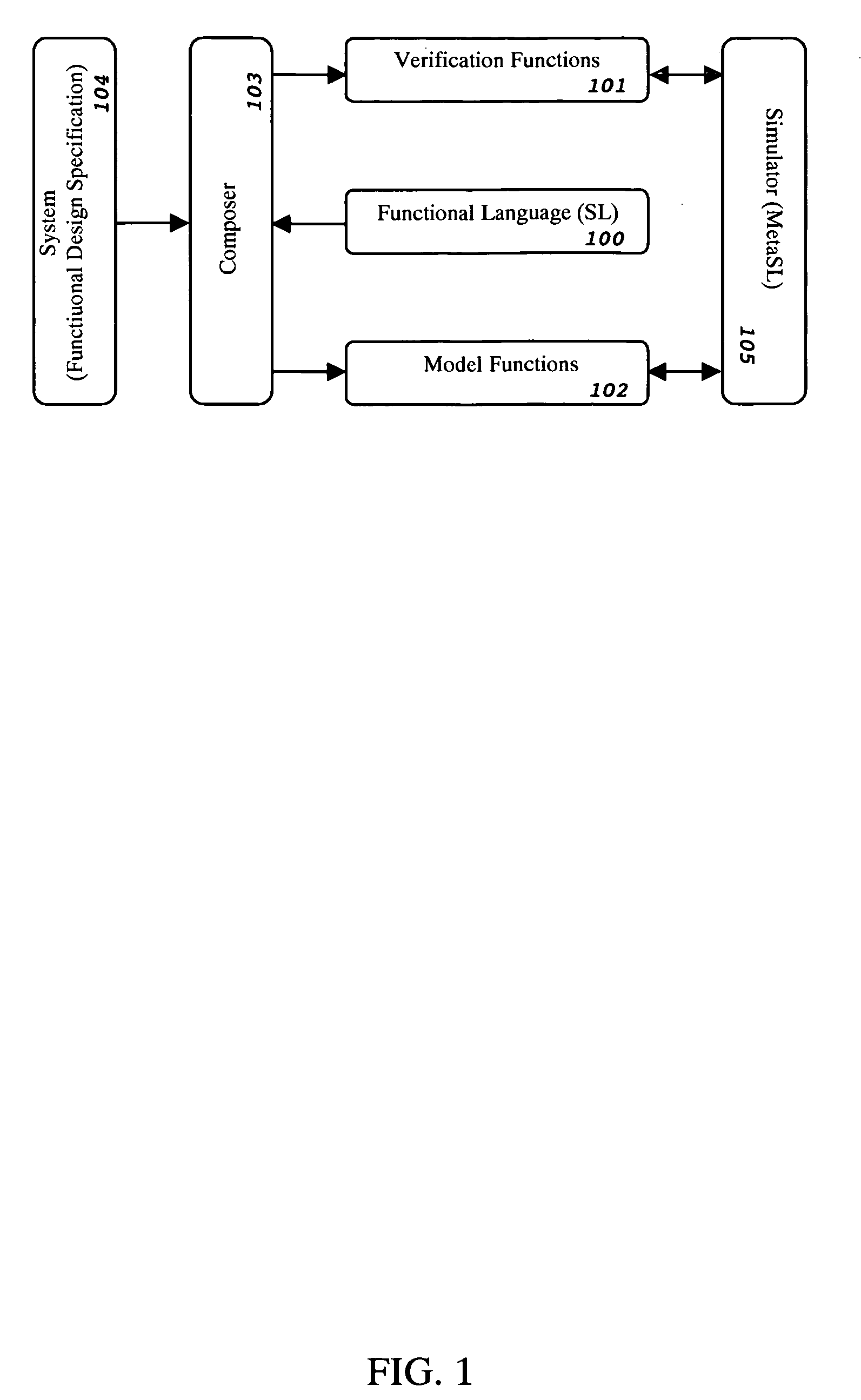[0012] The invention SL language is built around the existing IEEE-1990 Scheme standard. Scheme is a well designed language that has been adopted as an alternative to other
programming languages. The environment is interactive, allowing for incremental development and testing parts of user programs. Programs written in the language can also be compiled for
Intellectual Property (IP) protection and to make programs run fast. The invention language, SL, is an IEEE-based functional language with temporal constructs similar to those in
Verilog and other HDL languages, (always @ (posedge clka) . . . ), (@ (negedge clkb)), etc. It is a very high abstraction level language with all of the powerful functions defined in the standard. The language has additional functions for defining interface signals, connecting the interfaces, and a function to define multiple clocks and their parameters, such as
skew, positive phase,
negative phase, and initial value. Users may control and observe interface signals concurrently from different threads. When writing testbenches, users may synchronize their tests to different clocks. There are primitive
simulation control functions like ($simulate . . . ), ($stop), ($resume) and others similar to HDL
simulation environments, which might be used for more advanced user-defined functions. The invention SL language has very high-level, efficient means of abstraction allowing to program very complicated tasks. The interactivity combined with the possibility to compile makes the invention SL language easy to employ in testbench and simulation environments.
[0013] The invention SL language provides very high-level extensions for the intelligent testbench development that comprise temporal multiple
clock event modeling, modeling interface abstractions and concurrent
programming. It has an indisputable distinction from many existing testbench languages due to the fact that it is based on clear functional
syntax and
semantics. Users easily program functions inside functions, recursions which are simple as “goto” statements, maps and many other complex built-in functions. The language is invented for the purpose of reducing risk in testbench development and creating extremely compact model and test programs. The language functions themselves, can be represented and manipulated as the language data. The language reduces development time and variability in performance along with programming effort and variability of results and manages complexity by means of high order functions and easy emulation of existing verification methodologies.
[0019] The invention MetaSL environment includes a
graphical user interface (GUI) that facilitates the usage of the testbench development and simulation environment. The GUI provides features that visually help users benefit from the characteristics of the invention language even if they are not previously familiar with it. Users gets a higher abstraction level of the modeling and testing process so that verification of their designs can be accelerated. One of the features, visual programming, gives users a
source code reuse and guides for better modeling techniques, while the flexibility of developing testbenches is preserved.
[0020] The invention MetaSL environment is well suited for assertion checking and the invention SL language ensures an easy way of writing assertions to be validated either by
formal verification techniques or by
dynamic simulation. Assertions specified in other HVLs or property specification languages (PSLs) can also be verified in MetaSL and the environment can serve as a bridge between formal property verification and dynamic verification. The results provided by
formal verification techniques for models specified in the invention SL language and other HVLs or PSLS can be dynamically validated inside the MetaSL environment.
[0021] The invention provides means and methodologies for modeling and verification of large systems, for example, a multiprocessor system having several
concurrent computing elements with multifunctional queues, memories, buses, arbiters, etc. The graphical MetaSL environment simplifies modeling and verification of the system at
instruction cycle levels and provides generic functions used in most
microprocessor designs, such as memory,
register file,
program counter, accumulator, arithmetic
and logic unit, etc. The MetaSL GUI ensures easily generating instructions by instantiating these functions whenever needed and calling them at different
clock cycles for every instruction. The visual environment prompts designers with relevant selections and instantiates functions automatically. In addition to features provided by the invention language, the invention environment eases the process of writing testbenches. Users may instantiate generic testbench functions such as random and constrained
instruction sequence generators, instruction uploading and other modules, and schedule execution of functional checkers. The invention debugging features help display the content of registers and memories, function execution traces and monitor concurrent interfaces.
 Login to View More
Login to View More  Login to View More
Login to View More 


